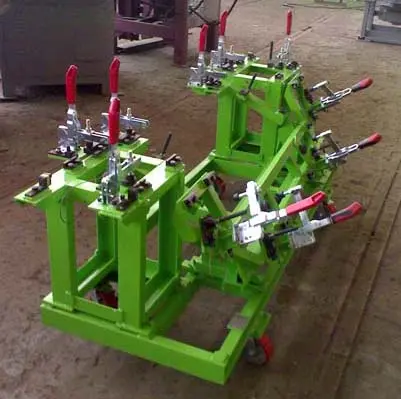Tips for Maintaining and Extending the Life of Your Manual Clamps
Posted by SRMT on Mar 27th 2024
Introduction to Manual Clamps: Basics You Need to Know
Manual clamps play a vital role in various settings like workshops and garages by securely holding objects together with inward pressure. While simple in design, their versatility is unmatched. C-clamps excel at securing materials on work surfaces, bar clamps offer extended reach and strong pressure, spring clamps are quick for small tasks, and hand screw clamps allow precise adjustments for woodworking. For most applications, Toggle Clamps are the top choice. Mastering these basics enhances project results and prolongs clamp lifespan through proper care. Choose the right clamp to ensure work safety and tool longevity.
Selecting the Right Manual Clamps for Your Needs
Choosing the right manual clamp might seem simple, but it's crucial for both your project's success and the clamp's lifespan. First, think about the job you need it for. Are you bringing pieces together for glueing? Holding a piece steady for cutting? Different tasks will need different clamp styles. For woodworking, bar clamps or C-clamps are often best. If you're working with metal, consider locking clamps. Size matters too. A clamp that's too big can be awkward, and one too small won't hold your work securely. Look for a clamp with the right opening capacity and depth to hold your workpiece effectively. Pay attention to the clamp's material as well. Metal clamps are durable and suited for heavy-duty tasks. Plastic clamps are lighter and great for light projects without risking damage to your materials. Lastly, consider ease of use. Your clamp should be straightforward to adjust and fit comfortably in your hand. Getting the right manual clamp isn't just about finishing your current project. It's an investment in all the projects to come.
Routine Maintenance Tips for Manual Clamps
Keeping your manual clamps in top shape isn't rocket science, it's all about sticking to a few simple habits. First off, always clean your clamps after use. Dust, dirt, and rust are the enemies here. Wipe them down with a rag to keep them looking and working like new. Next, don't forget to lubricate the moving parts. A drop or two of oil on the screw or slide mechanism makes a world of difference. This reduces friction, making the clamp easier to use and prolonging its life. Also, check for wear and tear. If you spot any cracks or significant wear on the clamps, it's time to replace them. Ignoring these signs can lead to failure at crucial moments. Lastly, store your clamps properly. Keep them in a dry, cool place to avoid rust and other damage. A little bit of care goes a long way in ensuring your manual clamps are ready for action anytime you need them.
Cleaning Your Manual Clamps: Best Practices
Keeping your manual clamps in top condition isn't just about using them right; it's also about cleaning them properly. Dirt, grime, and rust can not only make your clamps harder to use but can also shorten their lifespan. To ensure your clamps stay in good shape, follow these simple yet effective cleaning tips. Start by wiping down your clamps with a clean, dry cloth after every use. This removes any immediate dirt and prevents buildup. If you've been using your clamps in a particularly dirty environment, you might need to use a mild detergent mixed with water for a more thorough clean. Make sure to dry the clamps completely afterward to avoid rusting. For stubborn rust spots, a bit of steel wool or sandpaper can do the trick. Just be gentle to avoid damaging the clamp's surface. Once clean, applying a light coat of machine oil will protect the metal from moisture and rust. Remember, regular maintenance doesn’t just keep your clamps working better; it extends their life too. A little effort goes a long way.
Proper Storage Solutions for Manual Clamps
Keeping your manual clamps in good shape starts with how you store them. It's not just about tossing them in a drawer or on a shelf. First off, make sure they're clean and dry before putting them away. This stops rust and keeps them in tip-top shape. Think about hanging them on a pegboard or in a dedicated drawer with some padding. This way, they don't knock into each other and get damaged. If you've got the space, organizing them by size or type can save you time and headaches later. Plus, it'll be easier to grab what you need without having to sort through a jumbled mess. Remember, a little effort in storing your clamps can go a long way in making sure they last and perform well.
Regular Inspection: Key to Extending Clamp Life
Check your clamps often. Look for wear and tear, rust, or loose parts. If a clamp looks bad, fix it or get a new one. This keeps accidents at bay and ensures your clamps last longer. A worn-out clamp can fail when you least expect it, causing damage or injury. By keeping an eye on your clamps and addressing issues early, you extend their life and get more value for your money. Regular inspection is simple but crucial. Make it a habit.
Lubrication of Manual Clamps: When and How
Keeping your manual clamps in top shape means you've got to keep them well lubricated. Here's the deal: You don't have to grease them up every day, but you should follow a routine. Check on them every few months or more often if you use them a lot. The right time to lubricate is when you start noticing they're tougher to close or open. Now, for the how. Use a clean, dry cloth to wipe away any dirt or grime first. Then, grab a light machine oil – nothing too heavy – and apply a few drops to the moving parts. Work the clamp open and closed a few times to let the oil spread evenly. Wipe away any excess. That's pretty much it. Stay consistent, and your clamps will keep working smoothly for years.
Avoiding Common Misuses of Manual Clamps
To keep your manual clamps in top condition, steering clear of their common misuses is key. First off, never overload them. Manual clamps are designed to handle specific weights and pressures. Pushing them beyond these limits can cause damage or failure. Next, avoid using them for purposes they're not intended for. For example, using a clamp designed for woodworking in metalworking tasks is a no-go. The materials and conditions differ greatly. Another mistake is not regularly checking your clamps for wear and tear. Just like any tool, they need inspection. Look out for signs of damage like cracks or corrosion, and replace parts as necessary. Also, improper storage leads to trouble. Don't just toss them in a pile after use. Organize and store them in a dry area to prevent rust and damage. Lastly, neglecting to clean your clamps invites problems. Dirt and grime can build up, affecting performance. Wipe them down after each use. Avoiding these missteps will not only prolong your manual clamps' lifespan but also ensure they work effectively each time you need them.
Repairing Your Manual Clamps: DIY Tips
When your manual clamps start showing signs of wear or stop functioning as efficiently as they should, it doesn't always mean it's time for a new set. Often, a few simple repairs can bring them back to life, saving you both time and money. First off, regularly check your clamps for any loose parts. Tightening screws or bolts can often fix the problem right away. If the clamp pads become worn, consider replacing them instead of buying new clamps; most hardware stores carry replacements. For clamps that have become stiff or hard to open, a bit of lubricant can work wonders. Apply a small amount of machine oil to the moving parts, and they should be good as new. Remember, keeping your clamps clean is crucial. Dirt and debris can hinder their operation, so a quick wipe down now and then is advisable. By following these straightforward DIY tips, you can extend the life of your manual clamps significantly.
Conclusion: Maximizing the Lifespan of Your Manual Clamps
Taking care of your manual clamps properly boils down to some basic, yet crucial steps that ensure they last longer. Always clean them after use, preventing the build-up of residue that can degrade their quality. Regularly inspect for signs of wear and tear, and replace any parts that show damage. Use them as intended - pushing them beyond their limits can lead to premature failure. Store them in a dry place to avoid rust and corrosion. By following these straightforward, no-nonsense strategies, you significantly extend the life of your clamps, maximizing your investment in these essential tools. Remember, a little care goes a long way.



